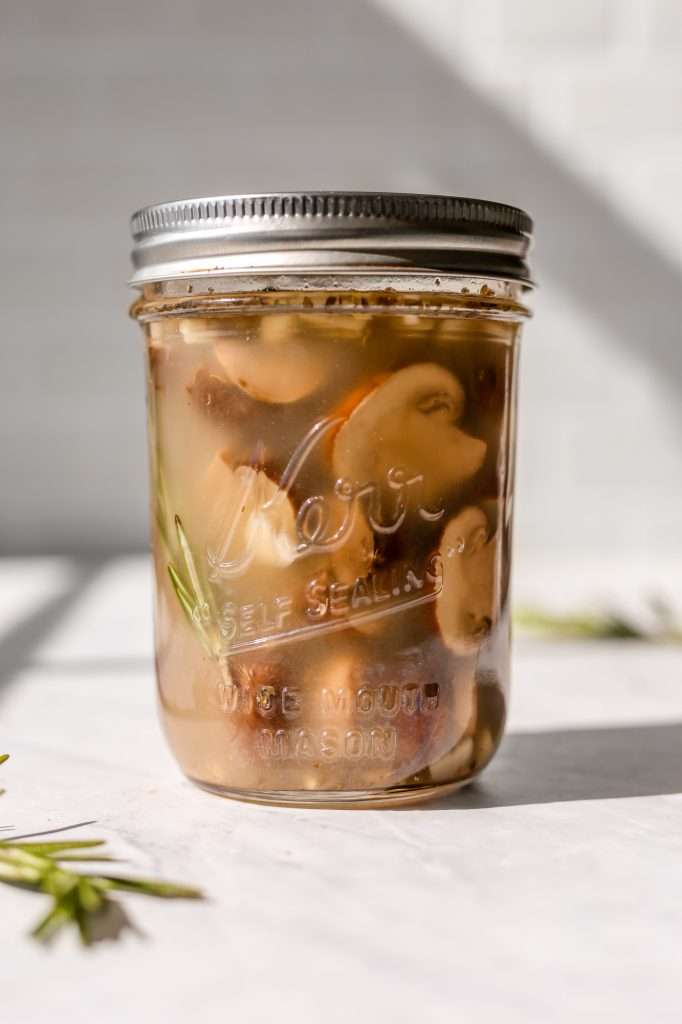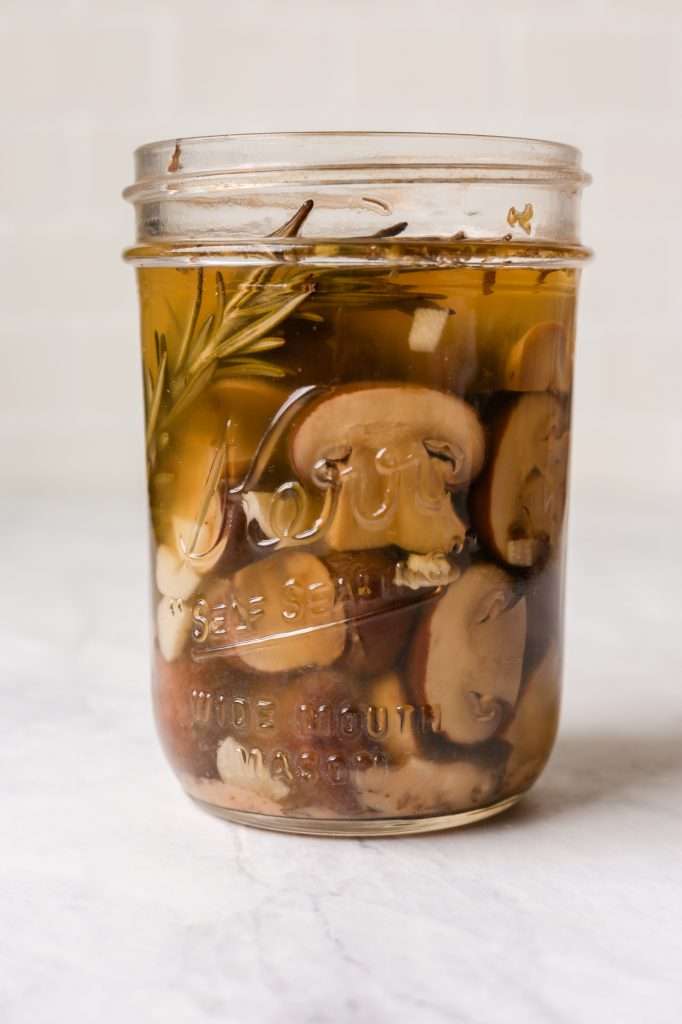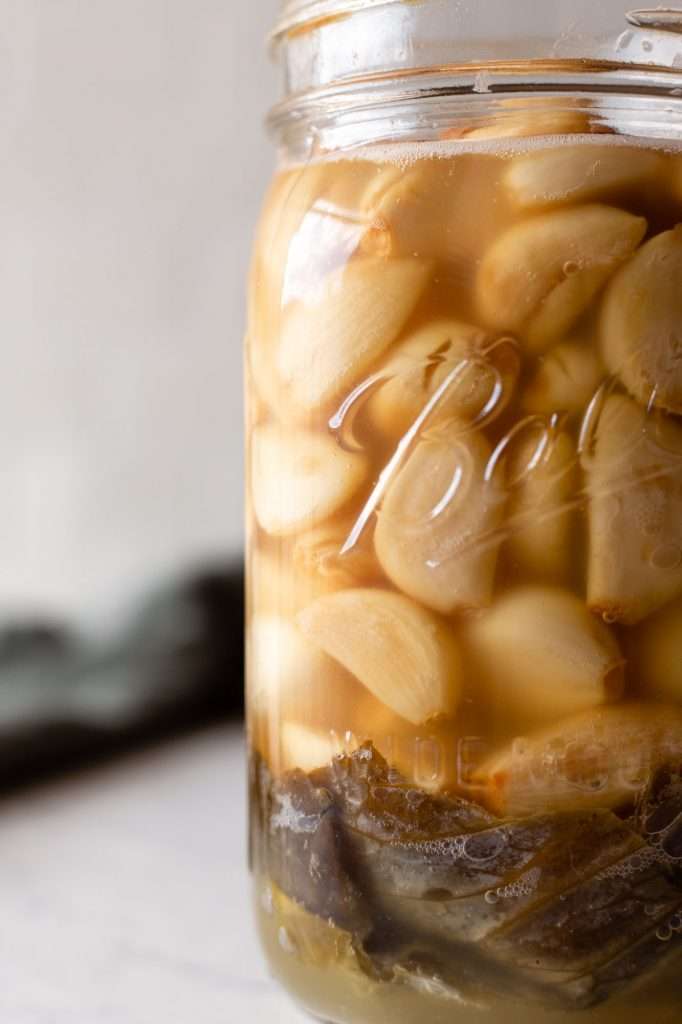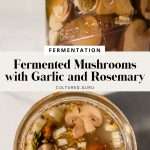Can You Ferment Mushrooms?
Over the years, many people have asked me if making fermented mushrooms is possible. The simple answer is yes! However, I do not recommend wild fermentation. Wild fermentation is when you add vegetables to a salt brine and allow the wild microbes on the surface of the vegetables to facilitate fermentation in an anaerobic environment.
Instead, I recommend a unique fermentation process that I call wild heirloom culturing. It’s a type of lacto fermentation process I came up with to ferment higher-sugar vegetables.

What is Wild Heirloom Culturing?
This method employs fermented sauerkraut brine (or any fermented vegetable brine; brine is the liquid in a jar of already fermented vegetables) and apple cider vinegar to ferment fresh vegetables. The wild heirloom cultures found in the fermented brine ferment the vegetables.
This fermentation method is more similar to yogurt fermentation than to something like sauerkraut fermentation… and it’s very similar to refrigerator pickling, but this recipe has beneficial microbes included.

Fermented Mushrooms
Certain mushrooms naturally contain a lot of fermentable sugars called FODMAPs. If you try to wild ferment high FODMAP fruits or vegetables, it usually leads to alcohol fermentation instead of lacto fermentation.
So if you can ferment in already acidic brine with many Lactobacillus already present, you can skip the first two stages of wild fermentation (you know, the part with all the bubbles). Lactobacillus bacteria only make lactic acid; they can’t make alcohol. So the mushrooms still ferment, but only the desirable fermentation occurs.
I’m not saying it’s impossible to wild ferment mushrooms in a salt brine. However, it is difficult and not consistently successful. Oftentimes, it ends up quite gross.
Other high FODMAP vegetables that can be difficult to wild ferment include garlic, onions, asparagus, artichokes, beets, and zucchini. Again, it’s not impossible to wild ferment these. It’s simply easier and tastier to use wild heirloom culturing.

Lacto Fermented Mushrooms
Another reason we want to use wild heirloom culturing for lacto-fermented mushrooms is that we must boil the mushrooms first. Since we boil them, there won’t be any wild microbes on the mushrooms left to start the fermentation.
So we rely on the microbes in fermented sauerkraut brine and apple cider vinegar to ferment the cooked mushrooms.
How to Ferment Mushrooms
You can try different mushrooms for this recipe, but I highly recommend baby portobellos; that’s what is pictured here. Here are all the types of mushrooms I recommend trying in this recipe:
- baby portobellos
- shiitake
- enoki
- button
- oyster

Fermented Mushrooms supplies
Supplies you need to ferment mushrooms:
- 16 oz Wide Mouth Mason Jar
- Fermentation Weight to fit your mason jar
- Standard Metal Mason Jar Lid (this can rust in the presence of salt)
- OR Rust Free Plastic Lid
- Unrefined Sea Salt
- Scale
- Mixing Bowl
- or you can use a Weck Jar
Fermenting Mushrooms
These fermented mushrooms are very easy to make. Since they are made with already fermented vegetable brine and apple cider vinegar, not much can go wrong. You need to remember a few things:
- Keep your fermenting mushrooms at a temperature between 70-80 degrees F. Keep out of direct sunlight
- Since this is a fermentation with added cultures from the sauerkraut brine, you only need to ferment the mushrooms for a short time.
- Keep refrigerated and consume within six months for full probiotic benefits!

More Fermentation Recipes to Try
- Fermented Quick Pickled Red Onions
- Homemade Fire Cider Tonic with Turmeric and Ginger
- Turmeric Napa Cabbage Sauerkraut


Fermented Mushrooms with Garlic and Rosemary
Learn how to make the most delicious fermented mushrooms with garlic and rosemary. Fermenting mushrooms is easy! You can ferment mushrooms in just 48 hours with this simple method.
- Prep: 10 minutes
- Cook: 5 minues
- Total Time: 0 hours
Ingredients
- 250 grams mushrooms, raw
- 115 grams (1/2 cup) white vinegar, 5% acidity
- Water
- 100 grams apple cider vinegar, 5% acidity
- 200 grams sauerkraut brine
- 1 sprig rosemary, fresh
- 1 tsp oregano, dried
- 1 tablespoon garlic, minced
- 5 grams sea salt* (see notes)
Instructions
- Wash mushrooms well in warm water, removing any dirt.
- Add the mushrooms to a pot with enough water to submerge them. They will float, but there should be enough water in the pot to press them all under the water.
- Add the white vinegar.
- Bring the mushrooms to a boil for 5 minutes, then drain immediately.
- Allow the mushrooms to cool to room temperature.
- Add the mushrooms, salt, rosemary, oregano and garlic to a clean glass jar.
- Top with the sauerkraut brine and apple cider vinegar.
- Close the jar with a lid and shake until it is well mixed.
- Allow the mushrooms to culture at room temperature for 48 hours.
- Refrigerate immediately and keep refrigerated.
Notes
- this recipe at 1x works best in a 16 ounce jar.
- You can leave the salt out for a lower sodium option. With the salt included the saltiness level is similar to brined olives.




















Do you need to use a fermentation weight for this recipe? For the 48 hrs culturing
You can, but you don’t have to as long as all the mushrooms are in the liquid.
Hello thank you so much for this blog! I started wild fermenting many years ago (I also have a blog post about it https://abundancedancegarden.wordpress.com/2014/10/10/the-simple-art-of-lacto-fermentation-an-introduction/)
However, I gave up for a while because I was getting inconsistent results, and didn’t want to waste food. Recently my son and I both got ill and I remembered his important it is to have fermented foods in your diet! I’m so happy I found your blog and the clear instructions about ratios.
I just gave a question about this recipe. Is the white vinegar necessary and if so, why? I have white vinegar but I use it only for cleaning, not eating. I’m wondering if the recipe would work with just boiling the mushrooms in water?
Thanks again 🙂
I gave
hi! yes, the vinegar is necessary. You should follow the recipe as it is written. You can use any 5% acidity vinegar though.
I’d love to try this recipe but I’m new to fermenting and need to ask what may be a silly question.
The key ingredient in this recipe seems to be fermented sauerkraut brine. Where does one get fermented sauerkraut brine? Does one have to make sauerkraut or can the liquid from store bought sauerkraut be used? I’m guessing the store bought product has been processed to destroy the active organisms that are required for fermentation.
Any suggestion for sources of fermented brine?
Fermented sauerkraut brine is the liquid in fermented sauerkraut. Store-bought is fine, as long as it’s raw fermented sauerkraut.
I don’t claim to be an expert on fermentation or anything, but I’ve successfully made many batches of beet kvass, sauerkraut, and the best kimchi known to man, and I’ve studied a bit about it. From all my research, I’ve found that when you use vinegar, it is NOT considered fermenting. When vinegar is used, it’s called pickling, which leads to a similar flavor, without any of the health benefits of actual fermented foods. I’m a bit confused why this recipe for pickled mushrooms is claiming to to be a recipe for fermented mushrooms. The article mentions that it’s “similar to [refrigerator] pickling”, because it IS pickling.
The distinguishing characteristic of pickling is not the presence of vinegar, it’s that pickling does not involve microbial metabolism. This recipe involves a ton of microorganisms. Just like you can use yogurt with live active cultures to culture your next batch of yogurt, this recipe uses sauerkraut brine to culture the mushrooms. The microbes are unharmed by vinegar, alive, active, producing enzymes, and developing the flavor more and more over time. Thus, it is fermented.
Hi. I love the idea of this recipe. Can you also use whey or kombucha for the starter liquid? Just curious because ask my sauerkraut brine absorbed back into the sauerkraut and my other vegetable brine have spices that I don’t think would go with this recipe. Thank you. I can’t wait to try this.
You can try it, but I haven’t tested the recipe with those ingredients, so I’m not sure what the results will be.
Why do the mushrooms need to be boiled? Is it for food safety or for a more pleasant texture? Thanks!
both
I am going to try!!!!!!!! Why do we use 5% vinegar instead of 7% ?
Thank you,
Priscilla
5% is standard safe acidity for store-bought vinegar used for pickling. if you have 7% that’s fine too because its more acidic.
Can the brine and vinegar be reused from batch to batch in this fermented mushroom recipe?
I think so! You should be able to reuse the brine for another batch.
I have both MOTHER vinegar ( purchased)……and home made cider vinegar, and, cider vinegar 5% (purchased).
1. Can the MOTHER vinegar be a replacement for the 200 grams sauerkraut brine? as a starter
2. Can the MOTHER vinegar be a replacement for the 100 grams 5% cider vinegar?
Sorry to ask this. It must be frustrating people wanting to change or substitute from the original recipe.
If you want to use only vinegar, they will be very sour, but you can try it. It will still be safe, because it’s so acidic, but super acidic to taste too.
I made a double batch of these using baby bellas and white mushrooms. They were so delicious I could have eaten the whole jar in a sitting. Can I reuse the brine from this batch to start another batch or will it be too vinegary? Or would i omit the vinegar the second time around since it’s already in the brine? All I know is that i need to make more of these STAT! I’m so glad I found your recipe.
yay! so glad you love the mushrooms! And thank you for leaving a review. You can reuse the same brine for a few batches and top off with more fermented sauerkraut brine and vinegar as needed.
Is the % daily value chart per serving or for the 16oz? Also, does fermentation reduce the harmful chemicals in these vegetables?
the % daily is for a serving size, as with any other nutrition label. And the calculated nutrition facts and serving size includes the brine. Check out the body of the blog post above the recipe card for details on the compounds in mushrooms and how cooking then fermenting works.
Thank you!
I’ve tried to ferment many foods, but was ignorant why certain foods didn’t ferment well like garlic & fruit. Learned something. I’ve also never fermented with vinegar to reduce pH. Will try to ferment mushrooms. Seems like this practice would be well established in Asia. Interested in making a “mushroom ketchup”, like Townsend’s, but fermented. Liked the idea of including garlic (&ginger), but never have done well with the ferment flavors that included garlic. Have not given up.
As I don’t happen to have sauerkraut brine on hand at the moment, and I’m not a microbiologist, do you think the brine from my fermented peppers or beans might be an acceptable substitute for the sauerkraut brine in this recipe? Yes, the alternative brines have got a lot of microbes in it, but there are differences in these kinds of brine vs brine from fermented cabbage
Thanks very much.
Sure, you can use the brine for any successful fermented vegetables.
Thanks Kaitlynn. Really appreciate your work.